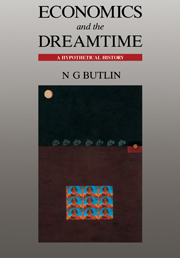Book contents
- Frontmatter
- Contents
- Preface
- Acknowledgements
- Figures
- Maps
- Tables
- Introduction
- Part I The palaeoeconomic history of Aboriginal migration
- Part II Development, structure and function of Aboriginal economy
- Part III Disease, economics and demography
- 12 Introduction
- 13 The problem of an exposed population
- 14 Re-estimating precontact populations
- 15 Turning the models around
- Part IV The establishment of a bridgehead economy: 1788–1810
- Part V The takeover process: 1788–1850
- Bibliography
- Appendix 1 Preliminary model/checklist of Aboriginal migration to Australia
- Appendix 2 NOAA depth contour maps
- Index
14 - Re-estimating precontact populations
Published online by Cambridge University Press: 06 July 2010
- Frontmatter
- Contents
- Preface
- Acknowledgements
- Figures
- Maps
- Tables
- Introduction
- Part I The palaeoeconomic history of Aboriginal migration
- Part II Development, structure and function of Aboriginal economy
- Part III Disease, economics and demography
- 12 Introduction
- 13 The problem of an exposed population
- 14 Re-estimating precontact populations
- 15 Turning the models around
- Part IV The establishment of a bridgehead economy: 1788–1810
- Part V The takeover process: 1788–1850
- Bibliography
- Appendix 1 Preliminary model/checklist of Aboriginal migration to Australia
- Appendix 2 NOAA depth contour maps
- Index
Summary
Demographic modelling and dynamics of shocks
The steps required for demographic modelling and the re-estimation of precontact Aboriginal populations are:
(a) the determination of the relevant parameters for a stable stationary population;
(b) the definition of the demographic shock effects from population disturbances;
(c) the computation of rates of population decline as the result of combined external shocks;
(d) plausible available estimates of numbers after shocks have been experienced (at the extreme, the level and dating of nadir populations); and
(e) extrapolation backwards from dates of post-contact populations to precontact estimates using the modelled rates of depopulation in (c).
The general perception of immediately precontact Aborigines is that they were in a stable relationship with their natural environment. Though some degree of demographic dynamism might be accommodated within such a concept, it is sufficient for present purposes to translate stability in relation to the natural environment to ‘a stable stationary population’. Possible dynamism apart, this does not preclude us from taking into account some precontact disturbances, such as major droughts, that may have created fluctuations in population levels. For the moment, it is assumed that any such fluctuations occurred around a trend condition of a stable and stationary population structure. A stable stationary population has several essential conditions. A consistent system to generate a stable and stationary population derives from mutually compatible life expectancy by age, gross reproduction rates, fertility conditions of a stable and stationary population structure.
- Type
- Chapter
- Information
- Economics and the DreamtimeA Hypothetical History, pp. 121 - 132Publisher: Cambridge University PressPrint publication year: 1993



